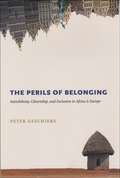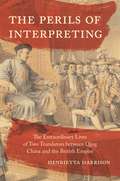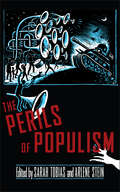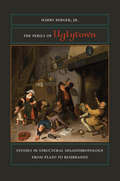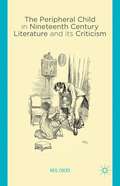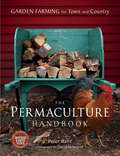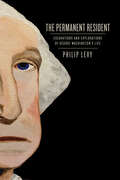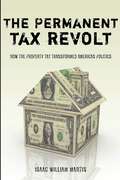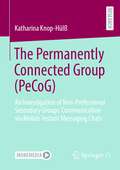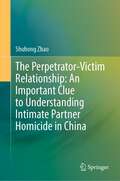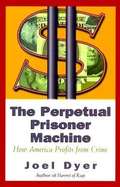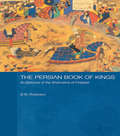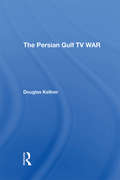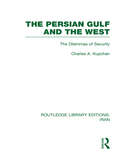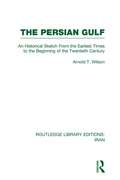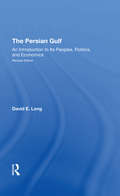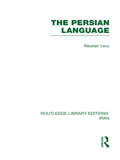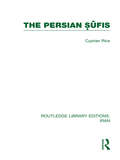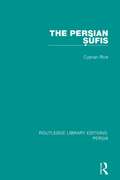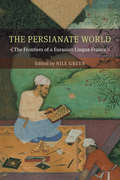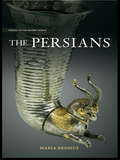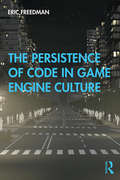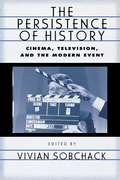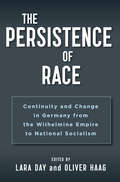- Table View
- List View
The Perils of Belonging: Autochthony, Citizenship, and Exclusion in Africa and Europe
by Peter GeschiereDespite being told that we now live in a cosmopolitan world, more and more people have begun to assert their identities in ways that are deeply rooted in the local. These claims of autochthony--meaning "born from the soil"--seek to establish an irrefutable, primordial right to belong and are often employed in politically charged attempts to exclude outsiders. In The Perils of Belonging, Peter Geschiere traces the concept of autochthony back to the classical period and incisively explores the idea in two very different contexts: Cameroon and the Netherlands. In both countries, the momentous economic and political changes following the end of the cold war fostered anxiety over migration. For Cameroonians, the question of who belongs where rises to the fore in political struggles between different tribes, while the Dutch invoke autochthony in fierce debates over the integration of immigrants. This fascinating comparative perspective allows Geschiere to examine the emotional appeal of autochthony--as well as its dubious historical basis--and to shed light on a range of important issues, such as multiculturalism, national citizenship, and migration.
The Perils of Interpreting: The Extraordinary Lives of Two Translators between Qing China and the British Empire
by Henrietta HarrisonA fascinating history of China’s relations with the West—told through the lives of two eighteenth-century translatorsThe 1793 British embassy to China, which led to Lord George Macartney’s fraught encounter with the Qianlong emperor, has often been viewed as a clash of cultures fueled by the East’s lack of interest in the West. In The Perils of Interpreting, Henrietta Harrison presents a more nuanced picture, ingeniously shifting the historical lens to focus on Macartney’s two interpreters at that meeting—Li Zibiao and George Thomas Staunton. Who were these two men? How did they intervene in the exchanges that they mediated? And what did these exchanges mean for them? From Galway to Chengde, and from political intrigues to personal encounters, Harrison reassesses a pivotal moment in relations between China and Britain. She shows that there were Chinese who were familiar with the West, but growing tensions endangered those who embraced both cultures and would eventually culminate in the Opium Wars.Harrison demonstrates that the Qing court’s ignorance about the British did not simply happen, but was manufactured through the repression of cultural go-betweens like Li and Staunton. She traces Li’s influence as Macartney’s interpreter, the pressures Li faced in China as a result, and his later years in hiding. Staunton interpreted successfully for the British East India Company in Canton, but as Chinese anger grew against British imperial expansion in South Asia, he was compelled to flee to England. Harrison contends that in silencing expert voices, the Qing court missed an opportunity to gain insights that might have prevented a losing conflict with Britain.Uncovering the lives of two overlooked figures, The Perils of Interpreting offers an empathic argument for cross-cultural understanding in a connected world.
The Perils of Populism (The Feminist Bookshelf: Ideas for the 21st Century)
by Amrita Basu Nancy Fraser Cynthia Miller-Idriss L. A. Kauffman Valentine M. Moghadam Sabine Hark Khadijah Costley White Heather Booth Scot Nakagawa Jyl JosephsonFrom Donald Trump in the U.S. to Jair Bolsonaro in Brazil, Viktor Orbán in Hungary, and Narendra Modi in India, right-wing populist leaders have taken power in many parts of the world. While each country’s populist movement is distinct, they are united by several key features, including the presence of a boastful strongman leader and the scapegoating of vulnerable populations, especially immigrants, people of color, LGBTQ people, and women. The Perils of Populism shows how a feminist lens can help diagnose the factors behind the global rise of right-wing populism and teach us how to resist the threat it presents to democracy. Featuring interdisciplinary essays about politics in the United States, the Middle East, Europe, and India from a variety of acclaimed theorists and activists, the volume contributes to a rapidly expanding literature on gender and the far right. Together, these chapters offer a truly intersectional analysis of the problem, addressing everything from how populism has thrived in a “post-truth” era to the ways it appeals to working-class voters looking for an alternative to neoliberalism. Yet the authors also find reasons to be hopeful, as they showcase forms of grassroots feminist activism that challenge right-wing populism by advocating for racial and economic justice.
The Perils of Uglytown: Studies in Structural Misanthropology from Plato to Rembrandt
by Harry BergerWith characteristic wit, Harry Berger, Jr., brings his flair for close reading to texts and images across two millennia that illustrate what he calls “structural misanthropology.” Beginning with a novel reading of Plato, Berger emphasizes Socrates’s self-acknowledged failures. The dialogues, he shows, offer up, only to dispute, a misanthropic polis. The Athenian city-state, they worry, is founded on a social order motivated by apprehension—both the desire to take and the fear of being taken. In addition to suggesting new politicaland philosophical dimensions to Platonic thought, Berger’s attention to rhetorical practice offers novel ways of parsing the dialogic method itself. In the book’s second half, Berger revisits and revises his earlier accounts of Italian humanism, Elizabethan drama, and Dutch painting. Berger shows how structural misanthropology helps us to read the competitive practices that characterize Renaissance writing and art, whether in Machiavelli’s constitutional prostheses, Shakespeare’s pageants of humiliation, or the elbow jabs of Dutch portraiture.
The Periodic Table of Feminism
by Marisa BateA cleverly nerdy review of feminist history told through the wide range of women who have shaped it, from Ruth Bader Ginsberg and Oprah to Beyoncé and The Spice GirlsA quirky, intelligent, and stylish review of the feminist movement, told through the stories of standout figures who have shaped it, The Periodic Table of Feminism charts the impact of female leaders from Betty Friedan and Ruth Bader Ginsburg to Michelle Obama and Oprah. Using the periodic table as a categorical device, the featured women are divided into "chemical" groups to show how the women and the battles they fought speak to each other across time and geography: Precious Metals: the face of the movements, like Simone De Beauvoir and Gloria SteinemCatalysts: Pioneers and fire-starters, like Susan B. Anthony and Sheryl SandbergConductors: The organizers, like Sojourner Truth and Rebecca SolnitDiatomics: Women working together, like The Spice Girls and The Women's Equality PartyStabilizers: Pacifists, like Margaret Atwood, Lindy West, and Eve EnslerExplosives: Radicals, anarchists, and violent uprisers, like Adrienne Rich and Roxane GayRejectors: "I am not a feminist" proclaimers, like Alice Walker and Sarah Jessica ParkerWith clever "top 10" lists--such as Feminists in Fiction, Feminists Before Feminism, Best Women's Marches, and Male Feminists--plus 120 meme-ready illustrations and inspiring pull quotes, this essential guide to feminism offers courage and inspiration for a new generation.
The Peripheral Child in Nineteenth Century Literature and its Criticism
by Neil CocksEstablished accounts of the child in nineteenth century literature tend to focus on those who occupy a central position within narratives. This book is concerned with children who are not so easily recognized or remembered, the peripheral or overlooked children to be read in works by Dickens, Bront#65533;, Austen and Rossetti.
The Permaculture Handbook
by David Holmgren Peter BaneThe urban landscape has swallowed vast swaths of prime farmland across North America. Imagine how much more self-reliant our communities would be if thirty million acres of lawns were made productive again. Permaculture is a practical way to apply ecological design principles to food, housing, and energy systems, making growing fruits, vegetables, and livestock easier and more sustainable.The Permaculture Handbook is a step-by-step, beautifully illustrated guide to creating resilient and prosperous households and neighborhoods, complemented by extensive case studies of three successful farmsteads and market gardens. This comprehensive manual casts garden farming as both an economic opportunity and a strategy for living well with less money. It shows how, by mimicking the intelligence of nature and applying appropriate technologies such as solar and environmental design, permaculture can:*Create an abundance of fresh, nourishing local produce *Reduce dependence on expensive, polluting fossil fuels*Drought-proof our cities and countryside*Convert waste into wealthPermaculture is about working with the earth and with each other to repair the damage of industrial overreach and to enrich the living world that sustains us. The Permaculture Handbook is the definitive practical North American guide to this revolutionary practice, and is a must-read for anyone concerned about creating food security, resilience, and a legacy of abundance rather than depletion.Peter Bane is a permaculture teacher and site designer who has published and edited Permaculture Activist magazine for over twenty years. He helped create Earthaven Ecovillage in North Carolina, and is now pioneering suburban farming in Bloomington, Indiana.
The Permanent Resident: Excavations and Explorations of George Washington’s Life (Early American Histories)
by Philip LevyNo figure in American history has generated more public interest or sustained more scholarly research around his various homes and habitations than has George Washington. The Permanent Resident is the first book to bring the principal archaeological sites of Washington's life together under one cover, revealing what they say individually and collectively about Washington’s life and career and how Americans have continued to invest these places with meaning.Philip Levy begins with Washington’s birthplace in Westmoreland County, Virginia, then moves to Ferry Farm—site of the mythical cherry tree—before following Washington to Barbados to examine how his only trip outside the continental United States both shaped him and lingered in local memory. The book then profiles the site of Washington’s first military engagement and his nation-making stay in Philadelphia. From archaeological study of Mount Vernon, Levy also derives fascinating insights about how slavery changed and was debated at Washington's famous home. Levy considers the fates of Washington statues and commemorations to understand how they have functioned as objects of veneration—and sometimes vandalism—for more than a century and a half.Two hundred years after his death, at the sites of his many abodes, Washington remains an inescapable presence. The Permanent Resident guides us through the places where Washington lived and in which Americans have memorialized him, speaking to issues that have defined and challenged America from his time to our own.
The Permanent Tax Revolt: How the Property Tax Transformed American Politics
by Isaac MartinTax cuts are such a pervasive feature of the American political landscape that the political establishment rarely questions them. Since 2001, Congress has abolished the tax on inherited wealth and passed a major income tax cut every year, including two of the three largest income tax cuts in American history despite a long drawn-out war and massive budget deficits. The Permanent Tax Revolt traces the origins of this anti-tax campaign to the 1970s, in particular, to the influence of grassroots tax rebellions as homeowners across the United States rallied to protest their local property taxes. Isaac William Martin advances the provocative new argument that the property tax revolt was not a conservative backlash against big government, but instead a defensive movement for government protection from the market. The tax privilege that the tax rebels were defending was in fact one of the largest government social programs in the postwar era. While the movement to defend homeowners' tax breaks drew much of its inspiration—and many of its early leaders—from the progressive movement for welfare rights, politicians on both sides of the aisle quickly learned that supporting big tax cuts was good politics. In time, American political institutions and the strategic choices made by the protesters ultimately channeled the movement toward the kind of tax relief favored by the political right, with dramatic consequences for American politics today.
The Permanently Connected Group (PeCoG): An Investigation of Non-Professional Secondary Groups’ Communication via Mobile Instant Messaging Chats
by Katharina Knop-HülßThe small group uniquely benefits from the ubiquitously available connective possibilities of mobile communication technologies. The group chat feature of mobile instant messaging applications (MIMAs, e.g., WhatsApp, Signal) provides small groups with a permanently accessible communication place where members can relay information to all others at once, independent of their spatiotemporal location. The resulting permanent collective addressability (PCA) of members has implications for group processes (e.g., group coordination, socio-emotional concerns of members). This book investigates the communicative activity in MIMA chats of 18 naturally occurring, goal-oriented groups in a non-professional setting using a standardized content analysis.It thus extends findings on individual-level expectations of permanent connectedness and shows how a group using such technology can be understood as a permanently connected group (PeCoG) and group-level manifestation of the hybridity of mediated and face-to-face communication constituting our current communication reality. Above all, this book demonstrates the potential of small group research to describe current phenomena relevant to communication science.
The Perpetrator-Victim Relationship: An Important Clue to Understanding Intimate Partner Homicide in China
by Shuhong ZhaoThis book is devoted to illustrating the significance of perpetrator-victim relationship, including its status and state, in understanding intimate partner homicide (IPH) in the context of China today after comparing with the findings in the previous studies. By analyzing the correlation between intimate relationships as a focal variable and other variables such as IPH characteristics and risk factors, a deeper understanding of IPH in China today has emerged. Finally, this book shows that many perpetrators and victims had intimate relationships with people outside their marriages as the main reason for the rapid increase in the number of instances of IPH, which seems to be in tandem with China’s rapid modernization and urbanization. Presenting the sole academic research that closely investigates the characteristics of intimate partner homicide in modern China, the book is a valuable resource for not only for the Chinese government but also for Chinese and international researchers.
The Perpetual Prisoner Machine: How America Profits From Crime
by Joel Dyera scathing indictment of the prisons for profit system in the U.S., which imprisons a greater % of its citizens than Russia or China
The Persian Book of Kings: An Epitome of the Shahnama of Firdawsi
by B W Robinson B. W. RobinsonThe Shahnama, written in the tenth century by Firdawsi, is the national epic poem of Persia. It chronicles at great length (nine volumes in the full English translation, currently out of print) the reigns and deeds of the earliest Persian kings, over fifty of them, in four dynasties - the Pishdadians, Kayanians, Ashkanians, and Sasanians. This book, illustrated with early Persian paintings which depict the deeds described, presents in easily accessible language a summary and re-telling of the Shahnama. It covers the entire epic in one volume, includes an introduction, together with lists of kings and dynasties, and thereby provides a concise overview of, and introduction to, this key work.
The Persian Gulf TV War
by Douglas KellnerDouglas Kellner's Persian Gulf TV War attacks the myths, disinformation, and propaganda disseminated during the Gulf war. At once a work of social theory, media criticism, and political history, this book demonstrates how television served as a conduit for George Bush's war policies while silencing anti-war voices and foregoing spirited discussion of the complex issues involved. In so doing, the medium failed to assume its democratic responsibilities of adequately informing the American public and debating issues of common concern. Kellner analyzes the dominant frames through which television presented the war and focuses on the propaganda that sold the war to the public–one of the great media spectacles and public relations campaigns of the post-World War II era. In the spirit of Orwell and Marcuse, Kellner studies the language surrounding the Gulf war and the cynical politics of distortion and disinformation that shaped the mainstream media version of the war, how the Bush administration and Pentagon manipulated the media, and why a majority of the American public accepted the war as just and moral.
The Persian Gulf and the West: The Dilemmas Of Security (Routledge Library Editions: Iran)
by Charles KupchanThis volume provides a broadly comparative and historical re-examination of the fundamental strategic dilemmas that confront the Western world in the Persian Gulf region. This systematic study of how the West has defined and dealt with its security interests in this region reveals three central strategic dilemmas: strategy versus capability, globalism versus regionalism, and unilateralism versus collectivism. The first part of the book focuses on US policy with particular emphasis on the Iranian Revolution and the Soviet invasion of Afghanistan. The author explains why there has been a persistent gap between American perceptions of the Middle East and the political and strategic realities of the region. The second part of the book examines the frustrated efforts of NATO members to form a cooperative response to their collective interests in the region.
The Persian Gulf: An Historical Sketch From The Earliest Times To The Beginning Twentieth Century (Routledge Library Editions: Iran)
by Arnold WilsonThis volume records the history of the Persian Gulf from the very earliest records until the 1920s. It records the rise and fall of ancient Empires and discusses the rule of Turks and Arabs. It chronicles the Western maritime nations – the Portuguese, Dutch, French and British – outstrip one another in trade and influence.
The Persian Gulf: An Introduction To Its Peoples, Politics, And Economics
by David E. LongSince the energy crisis of 1973, the political, economic, and strategic importance of the Persian Gulf to U.S. interests has become readily apparent. Yet little has been written on the area or on policy considerations toward it. This book, in its second, updated edition, fills a considerable part of the gap in the literature. The first chapter desc
The Persian Language (Routledge Library Editions: Iran)
by Reuben LevyThis book describes the structure of modern Persia, showing the methods by which it conveys meaning in sentences and connected passages and illustrating its special characteristics. As an introduction there is a brief account of Persia, its inhabitants, their occupations and beliefs; some attempt is made also to show how the language has been modified by the events of Persian history. A section is devoted to representative writings.
The Persian Sufis (Routledge Library Editions: Iran)
by Cyprian RiceThe Sufi phenomenon is not easy to sum up or define. This book is concerned primarily with the Persian mystics and looks at the history of the Sūfi movement, the mystical states, fundamentals of Persian mysticism and Sūfi practices.
The Persian Sufis (Routledge Library Editions: Persia #5)
by Cyprian RiceThe author was first introduced to Persian studies when, as a ‘Student Interpreter’ in the Levant Consular Service, he studied Arabic, Persian and Turkish. He realized the value of Persian thought in any attempt to draw East and West together. This book, first published in 1964, is the product of many years of close and constant contact with many Persian writers and academics.
The Persianate World: The Frontiers of a Eurasian Lingua Franca
by Nile GreenA free open access ebook is available upon publication. Learn more at www.luminosoa.org. Persian is one of the great lingua francas of world history. Yet despite its recognition as a shared language across the Islamic world and beyond, its scope, impact, and mechanisms remain underexplored. A world historical inquiry into pre-modern cosmopolitanism, The Persianate World traces the reach and limits of Persian as a Eurasian language in a comprehensive survey of its geographical, literary, and social frontiers. From Siberia to Southeast Asia, and between London and Beijing, this book shows how Persian gained, maintained, and finally surrendered its status to imperial and vernacular competitors. Fourteen essays trace Persian’s interactions with Bengali, Chinese, Turkic, Punjabi, and other languages to identify the forces that extended “Persographia,” the domain of written Persian. Spanning the ages of expansion and contraction, The Persianate World offers a critical survey of both the supports and constraints of one of history’s key languages of global exchange.
The Persians (Peoples of the Ancient World)
by Maria BrosiusThe only book of its kind to cover both the Achaemenid period and the thousand years following Alexander's conquest, The Persians explores the period from the seventh century BC, to the seventh century AD, and presents a comprehensive introduction to ancient Persia. Incorporating recent research, and translated sources from a wide range of corpus material, Maria Brosius explores the history of Persia, and brings a new understanding of Persian society and culture and the structures on which these empires were built: the king and his court; religion and culture; art and architecture. From the lands of Egypt to the Indus River, from the Russian Steppes to the Indian Ocean, Brosius has provided an up-to-date account of the three empires of pre-Islamic Iran, and discussing key topics such as women, religion and art and architecture, she presents a clear survey of the history of these empires. Providing additional reading references along with frequent source citations, students of ancient Persia will find this an invaluable addition to their course studies.
The Persistence of Code in Game Engine Culture
by Eric FreedmanWith its unique focus on video game engines, the data-driven architectures of game development and play, this innovative textbook examines the impact of software on everyday life and explores the rise of engine-driven culture. Through a series of case studies, Eric Freedman lays out a clear methodology for studying the game development pipeline, and uses the video game engine as a pathway for media scholars and practitioners to navigate the complex terrain of software practice. Examining several distinct software ecosystems that include the proprietary efforts of Amazon, Apple, Capcom, Epic Games and Unity Technologies, and the unique ways that game engines are used in non-game industries, Freedman illustrates why engines matter. The studies bind together designers and players, speak to the labors of the game industry, value the work of both global and regional developers, and establish critical connection points between software and society. Freedman has crafted a much-needed entry point for students new to code, and a research resource for scholars and teachers working in media industries, game development and new media.
The Persistence of History: Cinema, Television and the Modern Event (AFI Film Readers)
by Vivian SobchackThe Persistence of History examines how the moving image has completely altered traditional modes of historical thought and representation. Exploring a range of film and video texts, from The Ten Commandments to the Rodney King video, from the projected work of documentarian Errol Morris to Oliver Stone's JFK and Spielberg's Schindler's List, the volume questions the appropriate forms of media for making the incoherence and fragmentation of contemporary history intelligible.
The Persistence of Race: Continuity and Change in Germany from the Wilhelmine Empire to National Socialism
by Lara Day Oliver HaagRace in 20th-century German history is an inescapable topic, one that has been defined overwhelmingly by the narratives of degeneracy that prefigured the Nuremberg Laws and death camps of the Third Reich. As the contributions to this innovative volume show, however, German society produced a much more complex variety of racial representations over the first part of the century. Here, historians explore the hateful depictions of the Nazi period alongside idealized images of African, Pacific and Australian indigenous peoples, demonstrating both the remarkable fixity race had as an object of fascination for German society as well as the conceptual plasticity it exhibited through several historical eras.
